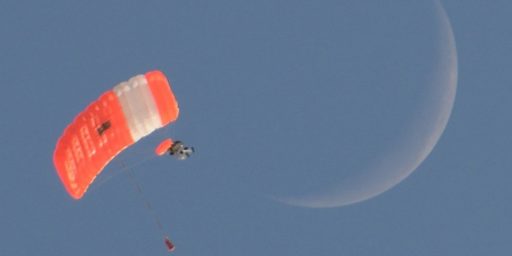Army’s New Parachute
Back in the days when men were men, Army paratroopers jumped with ‘chutes like the T-10 Charlie or the Dash One Bravo. Now, they’ve switched to wimpy little ‘chutes that provide soft landings.
Today’s soldiers are weighed down with a ton of gear, and the Army wanted a new parachute that could carry a paratrooper with a total jump weight of 400 lb. Last year, the service approved low-rate initial production for the new parachute, called the T-11 Advanced Tactical Parachute System; the 75th Ranger Regiment is supposed to be the first unit equipped this year.
Fred Coppola, the army’s deputy product manager for clothing and individual equipment, told me last year that the new chute would slow the rate of descent for a jumper weighing 385 lb to around 19 feet per second, versus the 22 feet per second of the old T-10. It’s the equivalent of jumping from a five-foot-high platform instead of an eight-foot jump — a difference that should save a lot of knees.
The new chute also has a lower oscillation rate (the jumper swings less from side to side on the way down), and the T-11 also has a lower “opening shock” rate: the canopy opens more slowly, so the jumper does not experience a heavy jerk when the thing finally opens.
In all seriousness, this is long overdue. Most retired paratroopers I know have the knees of men decades older. Beyond that, hitting the ground like a sack of potatoes leads to injuries which means troopers unable to do the very thing they’re supposed to do after landing — become leg infantrymen and continue their mission.






Given that the slower drop would mean a longer drop time, I’m assuming that vulnerability during the drop is not a issue? During WW2 (maybe Vietnam) and dropping into hot drop zones it would seem to be, but maybe even that would be offset by lower injury rates.
I do seem to recall tales told by WW2 airborne of the drop period feeling vulberable; feeling like the grounding would never arrive so that one could unlimber the weapon and shoot back or, at the very least, take cover. I think the very last thing those tale-tellers would have wanted was a longer, slower drop.
I’m not sure how modern ‘chutes compare to those in WWII. But we got out of the habit of dropping troopers over urban areas pretty quickly after that conflict, because it was so dangerous. It makes much more sense to drop them in safety and have them march to the fight. Of course, large-scale parachute jumps have lost their tactical relevance, anyway. We mostly use it for Rangers and special operators — small groups of men who can go in unnoticed, vice entire battalions.
How has the use of parachute dropped troops been affected by the invention of helicopters and air-mobile infantry?
I was an Army paratrooper from 1966 to 1968. The opening of the chute, while being quite a jolt, wasn’t the problem. Landing was a problem. It was next to impossible to slow your rate of descent down. You could attempt to do a correct PLF (parachute landing fall), but usually it was a violent end. Once, I landed so hard, I popped a rivet in my helmet liner. Still, I absolutely loved to jump.
Regarding the concerns about time airborne, the design of the T-11 looks like it could adjust descent speed with minor modifications (if it isn’t already designed to do so). If anyone with a more in-depth knowledge of the system can say that this wouldn’t work for some reason, by all means. Anyway, looking at the slits on the corners, I wonder if it would be possible to add a line on each corner to pull the slits open more (closer to circular, letting more air leave through them) during most of the descent, then released to let them narrow, slowing descent speed, near landing.